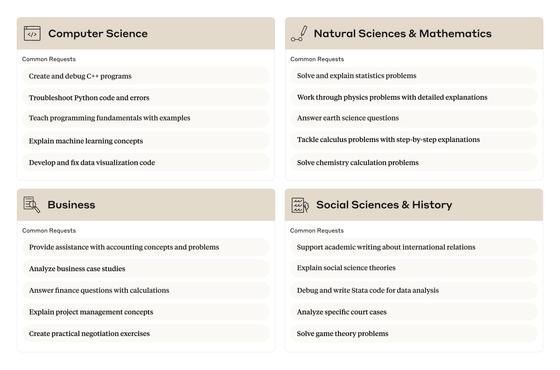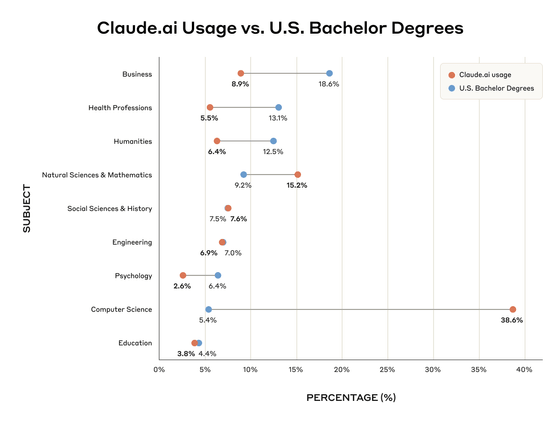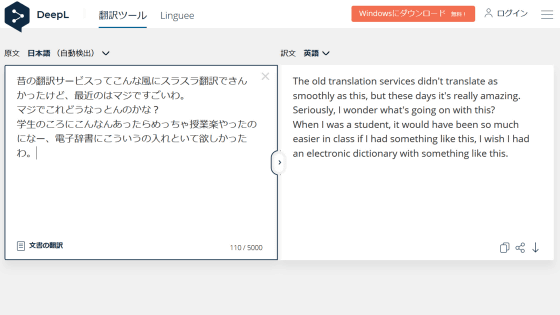What are college students using AI for? Anthropic releases survey results

Anthropic, the developer of the AI chatbot Claude, released a report on April 8, 2025 summarizing how college students are using AI.
New Anthropic research: How university students use Claude.
pic.twitter.com/apwAqH1ol3 — Anthropic (@AnthropicAI) April 8, 2025
We ran a privacy-preserving analysis of a million education-related conversations with Claude to produce our first Education Report.
Anthropic Education Report: How University Students Use Claude \ Anthropic
https://www.anthropic.com/news/anthropic-education-report-how-university-students-use-claude
To create the report, Anthropic used Clio , a tool that can automatically analyze conversations with Claude while protecting user privacy. Anthropic used Clio to examine 1 million anonymized conversations from Claude.ai accounts linked to university email addresses. After filtering these conversations by student and academic relevance, 574,740 conversations were extracted. Anthropic then grouped these conversations together for analysis.
The analysis found that of the 574,740 conversations, 39.3% of conversations were used to create and improve educational content across disciplines, such as editing essays and summarizing academic material, 33.5% were used to collaborate with AI to debug and fix errors in coding tasks, implement programming algorithms and data structures, and solve mathematical problems, 11.0% were used to analyze and visualize data, 6.5% to support research design and tool development, 3.2% to create technical diagrams, and 2.4% to translate and proofread content.
Below is a list of the most common requests Claude receives in the fields of 'Computer Science', 'Natural Sciences and Mathematics', 'Business', and 'Social Sciences and History'. Common requests include 'Write and debug C++ programs', 'Solve and explain statistical problems', 'Help with accounting concepts and problems', and 'Help with writing academic papers on international relations'.

Next, Anthropic conducted a survey to find out which academic fields Claude is most frequently used in. The results showed that Claude is most frequently used in the field of 'computer science,' with computer science requests accounting for 38.6% of all conversations. Anthropic noted that only 5.4% of all college students who use Claude in the United States are computer science students, which is 'disproportionate to the number of students in computer science.'
In contrast, only 8.9% of conversations on Claude were about business-related education, even though 18.6% of all college students are studying business-related education. Based on these results, Anthropic explained that 'while students studying business, health, and humanities have not integrated Claude into their academic workflows as much, students studying computer science may have adopted Claude early on. This may be due to the high awareness of Claude among computer science students and the high familiarity of AI systems with the tasks that computer science students perform.'
Below is a graph showing the academic fields and percentage of questions asked to Claude (orange) and the percentage of students attending American universities who major in computer science (blue).

In addition, Anthropic analyzed how students interacted with AI and identified four different interaction patterns. According to Anthropic, students' requests consist of four combinations: 'direct' (trying to solve a problem or challenge as quickly as possible), 'collaborative' (actively trying to interact with the model to achieve a goal), 'problem-solving' (seeking solutions or explanations to questions), and 'output-creating' (trying to create long output such as a presentation or essay).

Anthropic also analyzes how people interact with AI by field. As a result, in the natural sciences and mathematics fields, there were many requests for 'problem-solving' such as 'solving specific probability problems with step-by-step calculations' and 'solving assignments and exam problems step-by-step.' In addition, in fields such as computer science and engineering, there were many requests for 'collaborative' types, while in the humanities, business, and health fields, 'direct' and 'collaborative' types were evenly divided. The graph below classifies requests by field, from left to right: 'direct,' 'output creation,' 'collaborative,' and 'problem-solving.'

Anthropic pointed out some issues with its analysis, saying, 'It is unclear to what extent the use of Claude compares to the overall use of AI in education.' 'We analyzed conversations among accounts linked to university email addresses, so accounts identified as students may actually belong to staff or faculty, and it is possible that educational conversations are also taking place on accounts linked to non-university email addresses.' 'Due to privacy considerations, we only analyzed conversations from the past 18 days. Therefore, the results may be different if we analyze the data throughout the year.'
Related Posts:
in Software, Posted by log1r_ut







